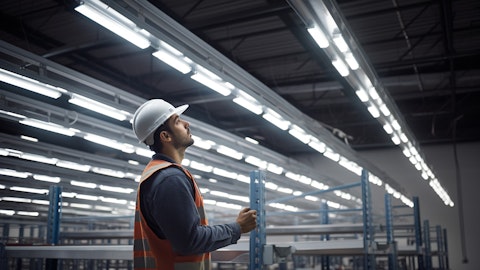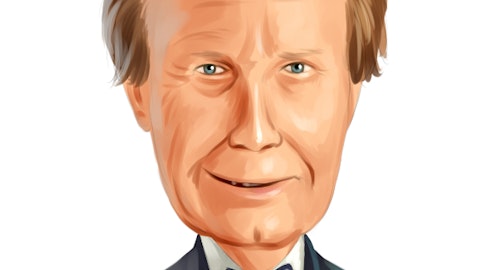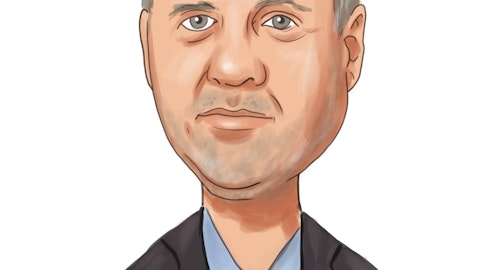Any of the timing on those things could be disrupted. In terms of R-290 versus our traditional solutions, right now everything is based on the traditional solution. Any changeover to R-290 are conversations that are going on now, and we anticipate that we have shipped these products, there is high interest in them, but we expect that the adoption rate certainly could take the better part of the year. I think most of our customers will look to experiment with the product, make sure that it performs to the expectations that where marketing it will perform to, we are very confident it will. But I think that in a solid process, they will take and they will slowly put this out into the field and see how it performs, provide feedback and then continue to move forward to that.
So I wouldn’t suspect that over the next year, this year, this calendar year 2024, in any of our calls, we are going to be talking about a big momentum shift. But, we will be supplying more and more of that product as we move forward.
Operator: Our next question comes from Amit Dayal with H.C. Wainwright.
Amit Dayal: With respect to this C-store investments and upgrades you are anticipating, Jim, do we have the products and offerings in place already to meet this type of demand or is that something you will be working on? Any insight on what kind of investments will be required to meet this potential cycle of upgrades?
Jim Clark: Absolutely, Amit. Thank you for joining. Thanks for the question. We certainly have the capacity, the skill and the experience to do it. As we talked about on other calls, this is our normal kind of course of business. We typically get involved. We are putting anywhere from 9 to 18 to 24 months of pre-planning of test systems back and forth, changes to what the actual products are going to be delivered and what they are going to look like. When a contract award is given, it’s not uncommon for us to be looking at anywhere from 18 to 36 to 60 months or longer project depending on the number of sites. We feel very confident that, we have not only these two opportunities and they will fit very well into our current production schedule, but that we also have additional capabilities and plans to scale up, as we move forward.
So within our current infrastructure, we have the plans — we have the capacity to handle this plus more to provide in our normal customers or another opportunity and we have the plans, which are not excessively capital-intensive to scale up beyond that. The only change that we have made to accommodate for these two large projects is, we are in a facility right now that allows us some expansion and we took on another, what was it, 12,000, 15,000 square feet, Jim?
Jim Galeese: Yes.
Jim Clark: 15,000 square feet. Just to give us a little bit more running room, but we could have done it within the space that we had.
Amit Dayal: And are you already seeing some of this in your other segments like QSRs, etcetera? I mean, it looks like you are benefiting from these types of investments by your customers already, right? Or maybe you will in the future?
Jim Clark: Yes, we are absolutely benefiting from the changes that are going on in the market, these competitive forces. As we have talked about often, we believe the sectors we are in, grocery being a very strong sector, the C-store sector. I talked about it a little bit in my comments earlier about a great Wall Street Journal article published last month. December 16th, it’s called Gas with a Side of Pizza. It just talks about that in-store transaction and how well we’re set up to deliver on those requirements. And it spans across the entire offering that we have: lighting, graphics, standalone displays, refrigerated displays, digital graphics, these are all key elements to that expansion and one that are really driving margin improvement for our customers not just in the petroleum space but in the grocery space, in the QSR space.
So, although grocery is temporarily disrupted right now, we still feel all of our original thesis is sound and it’s not going to be — it’s a temporary pause. It’s not anything structural to this market. And we believe it could really be a boom to going forward. And I want to underline, we have the capacity to be able to respond to it and we have the plans to be able to respond with additional capabilities if we need to.
Amit Dayal: Just one last question for me. The quality of earnings improvement on that front, is this here to stay or do you expect some variance from these levels going forward depending on how the marketing sales and other overhead needs develop to you as you scale your businesses?
Jim Clark: Yes. I mean you folks have been following us for a while. A lot of the people on this call have been following us for a while. We have plans to continue to get incremental improvements out of the business. I would define it as saying we still have a lot of runway left in front of us. We’ve talked about this on prior calls that there is still just environmentally out of our control, but general environmentally opportunities, supply chain is — we’ve always been able to manage the supply chain very well, and we’ve had a lot of advantages that we have been able to extract from that and will continue to. But as that continues to improve outside of our control, that’s going to benefit us. Stable labor and workforce that has continued to benefit us.





